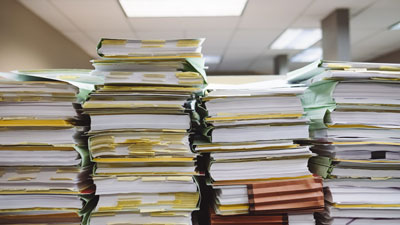
Businesses created within the last decade or so are often digital-first, if not digital-only. Many older businesses are interested in making the transition. Some have already started making steps towards it.
The challenge is often legacy paperwork and the processes attached to it. Here are some reasons to tackle that challenge and some tips to help.
1. Going paperless offers more flexibility
Getting rid of physical paper breaks the link between the location of a document and the knowledge of its contents. Possibly the most obvious result of this is that it enables remote working.
Even if you’re not interested in going remote-first, it can still be very useful to be able to support remote working. Firstly, it can be an affordable and effective disaster-recovery strategy. Secondly, it can help ease space pressures, especially at busy times. Thirdly, you may need to offer at least some remote working options to fill certain positions.
Last but definitely not least, going paperless can allow you to streamline your processes. You may even be able to make use of automated tools to reduce the burden on your staff. This can free up their time for more productive uses.
2. Going paperless clears space
Space is money. Money saved buys as much as money earned. This on its own can be sufficient justification for going paperless. There’s also the fact that paper is a serious fire hazard. That’s also another good reason for going paperless. If there’s paperwork you need to keep (e.g. for compliance) move it to an offsite secure storage facility.
Even just getting rid of a few filing cabinets can be enough to make a meaningful difference to the functionality of your workplace. You could use the space to store other items or as workspace. You could leave it empty for better flow or decorate it for better aesthetics.
3. Going paperless enhances data security
For most businesses, it is vastly easier to keep track of information stored electronically than it is to keep track of pieces of paper. This makes it vastly easier to implement robust access controls. Post-GDPR, this may be the single most compelling argument in favour of going paperless.
GDPR compliance can be difficult when all your important information on customers or clients are stored in a filing cabinet. Losing a sensitive piece of information that is stored on paper is a lot easier than losing it digitally. To avoid fines and penalties, making sure your important documents are scanned and stored digitally with access only for certain people is essential.
4. Lower costs
The cost of paper can add up especially if you’re in an industry where copying documents is commonplace. Going paperless and having all the documents you need scanned and stored digitally stops the expensive loop of buying new paper, printer ink and even copier maintenance costs.
Copying and printing also take up a significant amount of staff time and as we all know, time equals money. With the time that employees are copying their important document, it could have been shared digitally in second, leaving them more time to focus on their work.
5. Environmental impact
The process of creating paper has significant impacts on our environment due to heavy usage of chemicals, water, and deforestation. Going paperless can help decrease the impact that the paper industry is having on our planet.
42% of all logged trees are used for the pulp and paper industry so if everybody in the world stopped using paper, deforestation would be cut by almost half. Not only are the paper industry one of the top contributors to deforestation but they also contribute heavily to water pollution and global warming.
Tips for going paperless
For many businesses, especially SMBs, the most effective approach to going paperless is the “lift and shift” strategy. Scan everything you have on paper (get someone else to do this for you if necessary). Organize it exactly as you have it in the real world. For example, if you have three filing cabinets with three drawers, you need three folders with three subfolders.
Another way to limit the use of paper in your office is e-signatures. Signing important documents digitally not only saves on paper but gives every person who signs, a digital copy that they can secure in any way they see fit.
Note taking apps are perfect for employees that often jot down important things to remember in meetings. Most apps have great functionality like giving multiple people access and being able to read them on different platforms.
Progressing from the initial transition

With this done, go through the scans checking that you are happy with the quality. While doing this identify any paperwork which needs to be kept in paper format. Corral it together and move it offsite. The rest of your paperwork can be shredded and recycled.
Again, it may be best to get a third-party vendor to do this for you. Firstly, this will ensure that the job is done with maximum efficiency and minimum speed. Secondly, it will give you documentary proof of the destruction. This could come in very useful if anyone ever audits your data security.
Moving forward into the long term
If you’re still using paper as part of your regular processes, then you’ll need to implement a system for scanning and processing it. Ideally, however, you should be aiming to minimize the amount of paper you use.
For example, if you’re sending out paper forms, then switch to online ones. These are easy to create and complete and don’t need to be posted. If you’re still using traditional fax machines, then you should definitely look at switching to eFax. This is now reliable, secure and very economical. It also eliminates the need for bulky fax machines.
Is your business looking to go paperless?
If you think your business would benefit from becoming a paperless, digital space, please feel free to contact our team today. Our team are happy to go through all the processes and additional services we can provide for your business.
